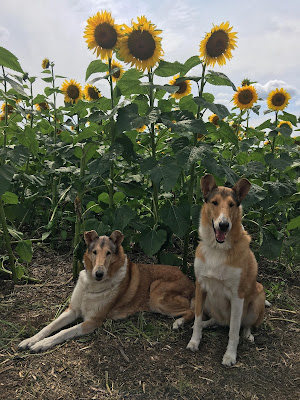Once in a while a dog comes along that seems to have a natural ability to connect with us on a deeper level than others.
This dog just seems to just “get us.”
People have a few different ways to describe these dogs, but I prefer “heart dogs.” Why do we
call them “heart dogs?” Because they are
able to touch our hearts in a special way, they become so much more than just a
companion animal. It doesn’t mean that we
don’t love the others, we do, and they each have a special place in our
hearts. But true “heart dogs” are the
ones we cling to in times of grief and stress.
They are the ones that know our moods before we do, and they are the
ones who can always make us smile.
If you are lucky, you get to share part of your life with one of
these dogs. And sometimes, if you work
at communicating and understanding your other dogs, you can have multiple heart
dogs in your lifetime. So many people, when they suffer
the loss of that beloved dog, swear there will never be another like him or
her. I believed that to be true once,
but since then I have had other heart dogs enter my life. I have discovered that the more you strive to
understand your dog, what motivates them, what brings them happiness and joy,
the deeper the connection you will have with them.
 |
| Sophie as a little pup |
Take one of my young collies, Sophie, for instance. She is a sweet, lovable collie. She is often goofy, sometimes clumsy in that
bumptious puppy way, and still has her occasional naughty moments. I loved her from the moment she was born, and she is definitely part of our family, but the deeper connection wasn't there. But when I started spending more individual time
with her, she just blossomed,and so did our relationship. She is still
goofy and occasionally naughty, and she still seems to be a bit clumsy. But now she is focused on me, what I want
from her, and what she can do to make me happy.
Always an affectionate puppy, she is now glued to my side, constantly
trying to give me collie kisses and cuddles (in her own uncoordinated, lovable way).
After taking a few obedience classes, Sophie now can sit,
stay, down, and come when called. She
knows what “leave it” means, and eagerly waits to hear the “take it”
command. When she is on a sit-stay, and
I call her to me, she rushes to me, immediately sits and focuses on
me. She gazes straight into my eyes, and
waits to hear me tell her what a “good dog” she is, and how proud I am of
her. It is truly amazing what just a
small amount of obedience training can do for any dog, they seem to change
overnight. Now I get that not every dog
will pick up on training this quickly, I had already laid the ground work with
Sophie when she was just a couple weeks old. Early socialization and training made
a huge difference in the adaptability of all the puppies in the
litter. One of Sophie’s brothers has
already earned a herding title and another is flying through his training to
become a service dog. They are deeply loved by their new families, and I couldn’t be prouder of them. But even dogs who were never exposed to early training as young pups can learn. All dogs, no matter what age, can learn. It's what happens to our relationship with those dogs, when we strive to teach them and understand what motivates them, that amazes me.

When we work with our dogs, spending time and focusing on them individually, a deeper bond begins to form. Before you even realize what is happening, you have taught that dog so much more than just how to sit or come when called. You have taught them to trust you, and to try to please you, and given them tools to earn your praise. Sophie and I have a way to go in her
training, but I think we could compete in obedience one day, she definitely has
the potential. But even more important, she has the desire and enthusiasm needed to continue on through the next levels of obedience training. Last Sunday night,
she graduated from her basic obedience class, and her instructor suggested she
might excel in agility too. I’m not sure
which direction we will go, but I am sure Sophie will make the journey
fun. She has already wrapped me around
her paw, and I fully expect to one day be posting about how she has become my
newest “heart dog.” She already makes me
laugh every single day, and she seems to naturally intuit when I need comfort. I think my life would be diminished without her in it. I honestly think all dogs have the ability to
become our “heart dogs,” they just need patience, understanding, training and time. As in any relationship, you get out what you
put in…




























































